Menus
- The Broughs ask
- Revolt against the druid fork
- Brough Superior Mark 1 in the video
- Brough Superior Mark 1 not the most expensive
- Norton ad for funding
- Brough Superior Overhead 680 from 1926
- Slightly modified Harley fork
- Overhead 680 more handy and precise
- Homogeneous whole instead of a pile of parts
- Brough Superior Mark 1
- Brough Superior Overhead 680
- History Brough Superior
- Colonel T.E Lawrence
- Racing successes
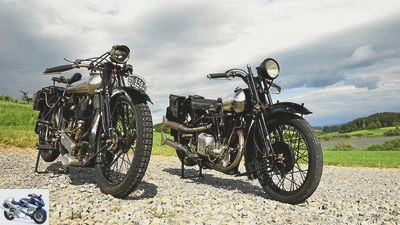
Gargolov
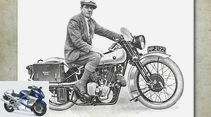
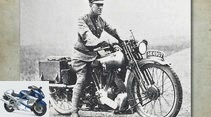
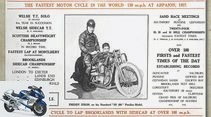

32 photos
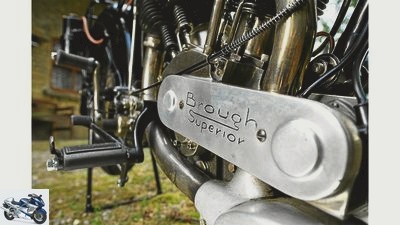
Gargolov
1/32
Ever since the author Ralf Schneider first heard of Brough Superior, he has always dreamed of driving one of the legendary machines.
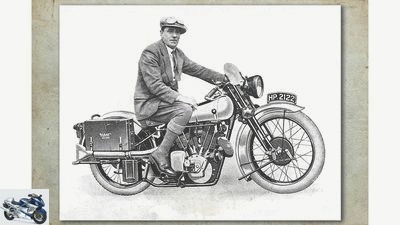
Gargolov
2/32
From the brochure for 1927: George Brough on a racing SS 100 with touring equipment.
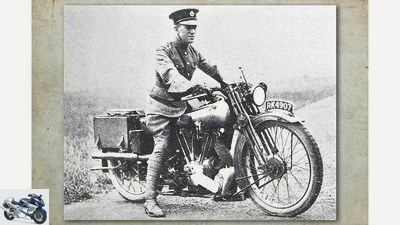
Gargolov
3/32
In 1923 “Lawrence of Arabia” withdrew from Middle East politics and served as a simple soldier in the Royal Air Force. In letters to George Brough, Lawrence praised his motorcycles and bought seven Brough Superiors one after the other. In 1935 he fell at high speed and died shortly afterwards of severe head injuries.
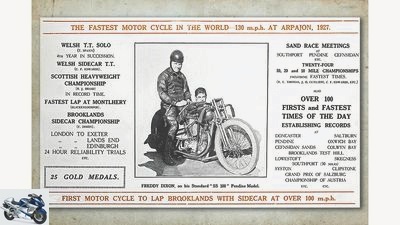
Gargolov
4/32
In the high-tempo 1920s, speed records developed a high advertising value and so Broughs took part in the general record hunt. The 130 miles per hour advertised in the above brochure correspond to 209.21 km / h.
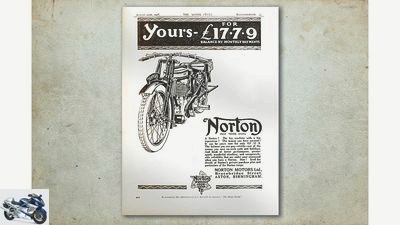
cutter
5/32
Just before the Brough Superior Overhead 680 hit the market for over £ 100, Norton needed private funding to boost sales of the inexpensive 16H.
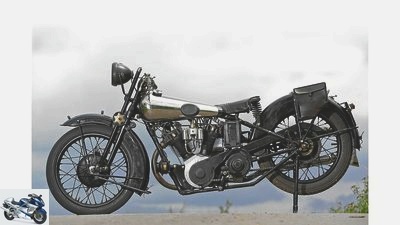
Gargolov
6/32
Brough Superior Overhead 680 (1926). Apart from the slight lean angle, which hinders it a bit on winding roads, it is good for a considerable country road speed.
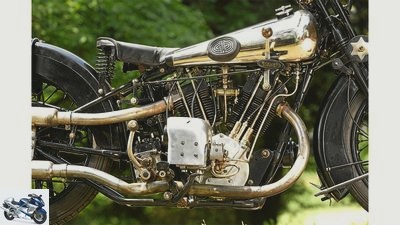
Gargolov
7/32
In contrast to earlier Brough Superior, the magneto is not located in front of the engine, but to the right of it, near the mechanical oil pump.
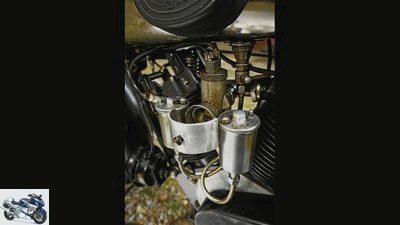
Gargolov
8/32
A collar in front of the intake port is apparently supposed to protect the 680’s carburetor from sucking in larger chunks.
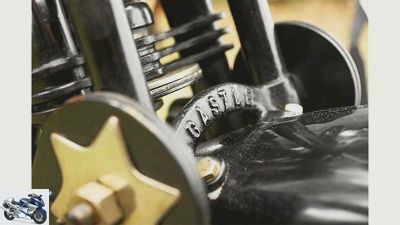
Gargolov
9/32
The Castle fork modeled on Harley-Davidson brought enormous progress in terms of chassis technology.
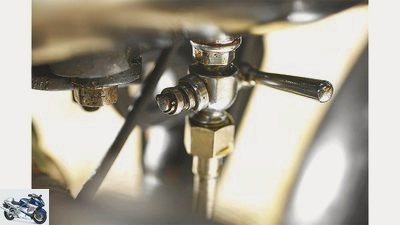
Gargolov
10/32
The life of the engine depends on the opening of this oil tap before the start.
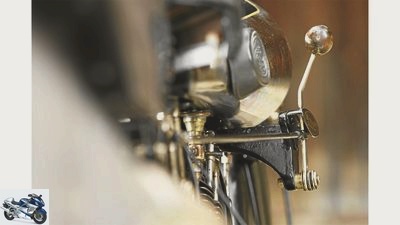
Gargolov
11/32
This bracket for the gearshift lever, which was moved to the front, was introduced by George Brough with the Overhead 680, and later all “brufsup” received this arrangement.
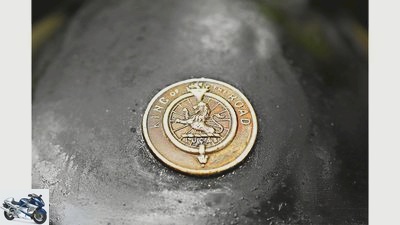
Gargolov
12/32
As this badge shows, the 680’s electrical system comes from Lucas. The slogan “King of the Road” later provoked the sarcastic “Prince of Darkness”.

Gargolov
13/32
In this picture the Castle fork reveals the seat of its springs.
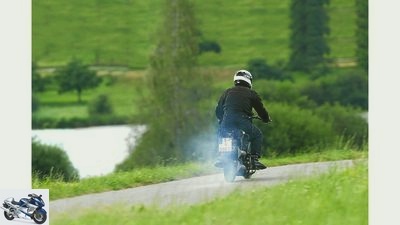
Gargolov
14/32
When the oil pump is well adjusted, the 680 V2 puffs out blue clouds of oil from time to time. Don’t worry, it’s all good.
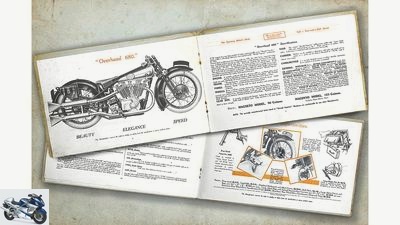
Gargolov
15/32
It is very likely that the picture in the brochure shows the same copy of the 680 that Schneider was allowed to carry out on country roads in southern Germany. The prospectus is a facsimile of the original booklet from 1926/27.
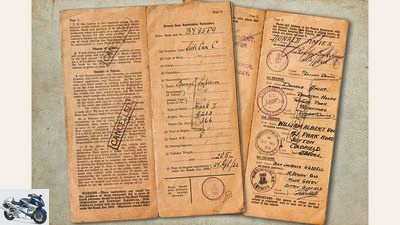
cutter
16/32
… the registration certificate records the first owners and the “road act” from 1920.
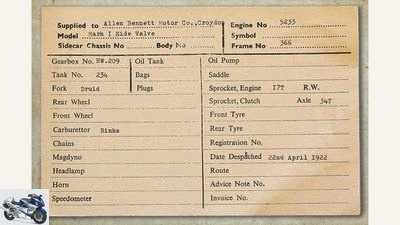
cutter
17/32
The “works record card” certifies the originality of the Mark 1, …

Gargolov
18/32
Recently this dream came true – even twice.
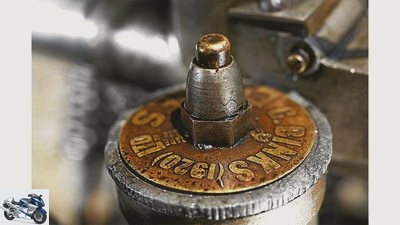
Gargolov
19/32
However, there are a few things to consider before starting. With the air flap, which gave the Binks carburetor its name “mousetrap” (mousetrap), the inflow cross-section and thus the flow speed can be varied.

Gargolov
20/32
The swab floods the well-patinated swimmer chamber – make sure to let it overflow before starting.

Gargolov
21/32
Many more steps are necessary (you can see these in the video) before you can accelerate with the Brough Superior Mark 1 as befits its standing.
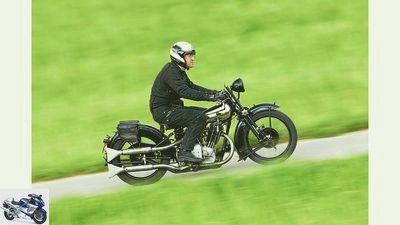
Gargolov
22/32
In comparison, the smaller and younger Overhead 680 is much less complicated.
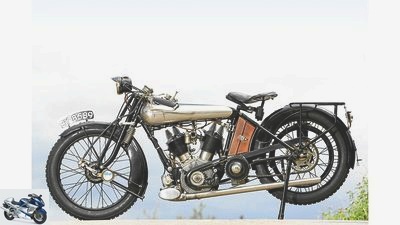
Gargolov
23/32
Brough Superior Mark 1 from 1922.
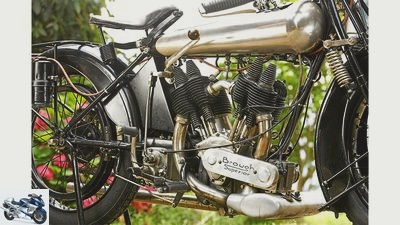
Gargolov
24/32
The upright valves are mounted from above through holes that are made on the Mark 1 …
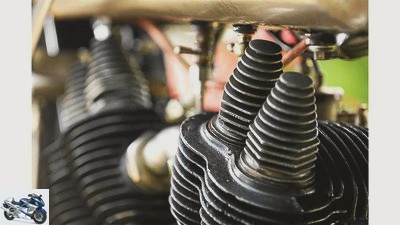
Gargolov
25/32
… are closed by real “cooling towers”.
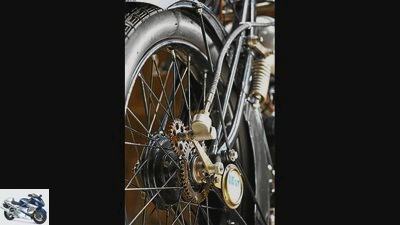
Gargolov
26/32
The mechanics in the photo are not used for the front wheel but for the speedometer drive.
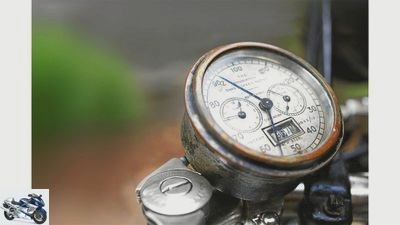
Gargolov
27/32
A treasure of treasure: Bonniksen speedometer and mileage counter. As befits a Brough Superior, the scale goes up to 100 miles per hour.
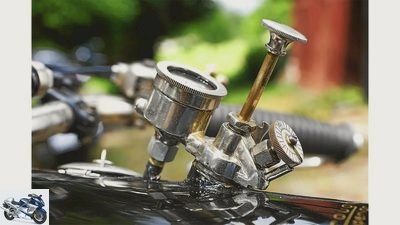
Gargolov
28/32
On the left the most important unit for maintaining the engine: the oil pump with sight glass, stamp and metering wheel. The oil is thrown around the engine and hopefully gets to all the important places.
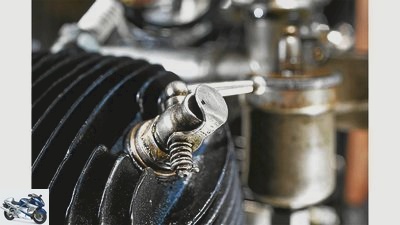
Gargolov
29/32
Through such a ball valve with a nozzle, petrol could be filled into the combustion chamber before a cold start. It also served to dilute the chewy oil a little.
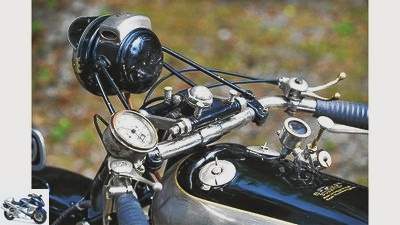
Gargolov
30/32
There is not only a lot to see on the handlebars, but above all to do.
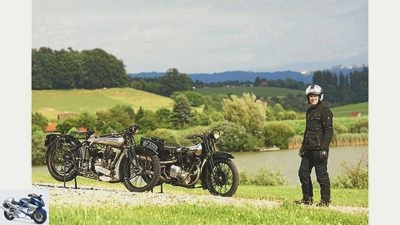
Gargolov
31/32
Ralf Schneider undoubtedly feels respect. Compared to the 90-year-old motorcycles as well as from the builders.
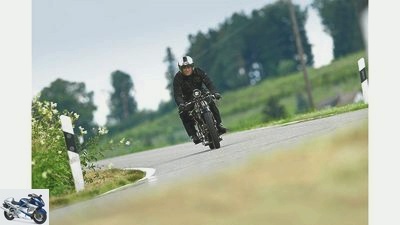
Gargolov
32/32
How could it be that these motorcycles, which actually consist entirely of bought-in components, enjoy such a reputation? The secret is probably in the dedication of their builders. This has created a homogeneous whole from a pile of parts and through it these personalities live on in a dead object.
Brough Superior Mark 1 and Overhead 680
The Broughs ask
Content of
Ever since I first heard about Brough Superior, I dreamed of driving one of the legendary machines. Recently this dream came true – even twice.
There is no better way to get started B.rough superior than the origin. Even George Brough’s debut, the Mark 1, which was produced from 1921, was long and low, had a large, powerful engine, the characteristic saddle tank, and was processed with the greatest care – in short, it had everything that made the brand famous both quickly and sustainably has made. Only six of an estimated 235 copies of the Brough Superior Mark 1 have survived; one from the very first series with the “90 bore” OHV engine from JAP and five with a 980 side valve V2 from the same manufacturer. Such a machine from 1922 can be admired in this story, another example from the same year, but equipped with a Montgomery fork instead of a Druid fork, will be shown until well into autumn as part of a special exhibition in the Neckarsulm two-wheel museum.
Buy complete article

Brough Superior Mark 1 and Overhead 680
The Broughs ask
Pull the clutch, first gear, take a deep breath
I listen particularly carefully to the instructions for handling the Brough Superior Mark 1. Open the fuel tap, only the left one, the right one is slightly incontinent. Use the swab on the Binks Mousetrap carburetor until the float chamber overflows, that’s easy. Then a hearty kick on the kickstarter, another, another. On the fourth, the aged engine starts with a fat, deep exhaust note. Well, it’s getting important. First of all, I must press a pump piston full of oil into the engine, which I must not forget afterwards. Then carefully push the advance lever in the early direction and open the air flap that gave the carburetor its nickname.
Set the correct idle speed on the throttle, pull the clutch, engage first gear on the fuel shift lever, take a deep breath. Slowly pull up the gas and engage the clutch, it drives. I immediately shift into second gear. Close the lever throttle, but not all the way, pull the clutch, grip the fuel control lever and carefully pull it back up. The third gear is too long to roll carefully, the speed is fast enough in the second and the engine is audibly comfortable. The Brough Superior Mark 1 carries me through a lonely Upper Swabian valley with an impressive patter. Meadows, isolated hamlets, now and then old trees stretch their branches across the road. It could have looked like this in 1922.
Revolt against the druid fork
In the first corner, which looks halfway like one, I noticed the stubborn turning behavior of the machine. The chassis geometry was apparently designed with emphasis on straight-line stability. The original registration certificate says that “my” Mark 1 was originally registered as a motorcycle with sidecar, and I suspect a special combination geometry as the cause of the steering behavior. A proven connoisseur of old motorcycles dispels the assumption: “Oh, they are all like that.” Later I read in Mick Woollett’s Norton book (Norton, The Complete Illustrated History) how factory driver Graham Walker had a revolt against the 1923 Tourist Trophy Druid Fork by replacing it with a much better functioning Webb fork. This applied equally to the suspension behavior and the geometry of the Druid and is probably also the reason for George Broughs experiments with the Montgomery fork, which he built into other copies of the Brough Superior Mark 1 in the same year.
Regardless, the initial alienation gives way to an insightful “that’s how it is”. I will force the worthy lady into the curves emphatically because she wants it that way. That being said, she really makes it as easy for me as she can. This is how the high processing standard manifests itself. The Brough Superior Mark 1 reacts promptly to the finger play with the accelerator and air lever, the ignition remains on “late” anyway, shifting down with double-declutching works very smoothly and so we find a country road pace that is sociable by today’s standards. I can now begin to imagine how far superior you must have felt with such a motorcycle in 1922. The engine runs on far too much oil because I inject it more often than recommended when it was first made. Just don’t cause any feeders.
Brough Superior Mark 1 in the video
Motorcycles like the Brough Superior Mark 1 were not built for sharp braking, and that was no different with a Harley-Davidson from 1916 and a BMW R 32 from 1925, both of which I rode. Although the 1922 Brough already had a half-hub drum brake in the front wheel in addition to the rear spoke ring brake, the idea of braking straight to the corner was probably not even widespread among racing drivers at the time. That fits the elasticity of the side valve motor and the complexity of its operation – speed was moderated with gentle gradients and not radically increased or decreased. The early brough could be rushed, but it had to be done with time.
One of the wonderful Bonniksen mechanical speedometers, an instrument of impressive complexity, adorns the left side of the handlebar. A massive gear train in the front wheel drives it, and it actually works. It’s not easy to read, but at least I understood that it doesn’t always show the current speed, but only every five seconds. This also fits in with driving operations in the 1920s, when the pace did not change as much during this time interval as it does today. By the way, I don’t think that the two big needles don’t work equally accurately, because I certainly didn’t drive 92 miles per hour with the Brough Superior Mark 1. 55 mph, i.e. almost 90 km / h, on the other hand. But I probably didn’t understand the Bonniksen in all its sophistication.
Subscribe to MOTORRAD videos on Youtube
Brough Superior Mark 1 not the most expensive
It’s not that important either. Much more important is the way the Brough Superior Mark 1 lets my mind fly back and forth between the time it was made and the present. Because despite their authenticity, I can’t pretend we’re traveling back to the 1920s together. Occasionally, today’s car appears behind us and the drivers look very surprised when overtaking. My diverse experiences with modern machines cannot simply be ignored. But like any object that has come to us from the past, the Brough gives me a very instructive history lesson and gives me food for thought and homework in abundance.
One question concerns their price and how it relates to other contemporary motorcycles. Closely related to this is the question of who could afford such a motorcycle in the UK at that time? As I found out, a serious comparison of purchasing power and wage levels in the 1920s with today’s conditions is beyond the scope of this story. However, there are already some indications. Peter Miller lists comparable motorcycles in his profound book on Brough Superior (Brough Superior, The Complete Story), and this comparison shows that the Mark 1, as an ohv model with a price of 175 pounds, is in the upper range, but was by no means the most expensive machine. The British Blackburne and Sunbeam cost £ 180 and £ 184.3, the US Harley-Davidson and Indian £ 196 and £ 186, respectively. With the side valve engine, the price of the Brough Superior Mark 1 dropped to £ 150.
Norton ad for funding
cutter
Just before the Brough Superior Overhead 680 hit the market for over £ 100, Norton needed private funding to boost sales of the inexpensive 16H.
The “Rolls-Royce of motorcycles”, as the Brough Superior Mark 1 was called, was not as far out of the world as the cars in terms of price. On the other hand, Mick Woollett equated a 1924 £ 72 Norton 16 H, a plain 490 side valve single-cylinder motorcycle, with about 20 weekly wages for a worker, unfortunately without naming its source. Nevertheless, one can assume that a worker would have had to save hard for at least two years to be able to buy a Brough Superior. Unless he had a family to support. Very many will not have made it, because after the post-war boom of 1919/1920 Great Britain suffered from high unemployment. An important reason for this was the decline in coal mining, which proved to be no longer competitive in international competition. While many motorcycle manufacturers lowered their prices under the impression of dwindling demand, the return to the gold standard in 1925 and the old exchange rate of $ 4.85 per pound made British goods more expensive abroad and contributed to a further decline in demand. The Norton advertisement shown on the left for the financing of a 16 H is an expression of the problem and, moreover, pure farm trapping, especially since it shows the amount to be paid for a 16 H differently – once with 17 pounds 7 shillings, then with 17 pounds 17 shillings. Neither the price of the machine – already reduced to around 60 pounds in 1926, depending on the equipment – nor the monthly installments.
Brough Superior Overhead 680 from 1926
In this environment, the Brough Superior Overhead 680 came on the market at the end of 1926. It has a prehistory in the form of a 680 with a side valve engine and the actually discontinued Mark 1 undercarriage, which George Brough had produced in 1925 for export to Europe, especially Austria. As mentioned, imports from Great Britain were very expensive there, so the Austrian importer’s demand for an inexpensive machine is understandable. But George Brough does not seem to have been entirely convinced of this model policy. For two reasons I suspect. Firstly because as a designer he rebelled against the inferior technology that did not match the “superior” in the brand name and secondly because he had probably recognized that in times of economic crisis one can only be successful with very cheap or exclusively expensive products.
The Brough Superior Overhead 680 not only got a powerful, high-revving ohv motor from JAP, but also a chassis derived from the top model SS 100. Their price was given as “96 guineas” for the version with magneto ignition and “103 guineas” for the version with electric lighting and horn. At first I assumed that the “guinea” was just a synonym for the pound, but that is not true. The Guinea gold coins were still current at the height of the Napoleonic Wars, but since 1813 the guinea was only used as a unit of account. Although one with “aristocratic overtone”, which is why it was mainly used to indicate prices for luxury goods. In value it is five percent above the pound. The guinea prices of the Overhead 680 sounded both more elegant and lower than the 100 pounds, 8 shillings, or 108 pounds, 2 shillings and 6 pence that were actually paid for it. Very clever in terms of sales psychology.
Slightly modified Harley fork
I chose the Brough Superior Overhead 680 and temporarily kidnapped it from the Brough special exhibition at the Neckarsulm two-wheel museum because I particularly liked it. The smaller, delicate engine, the smaller wheels and the slightly shorter wheelbase give it a special charm in my eyes. As has been shown when driving, it also fits my ideas of dynamism much better than the large-volume Brough Superior Mark 1. Anyone who moves the two in direct comparison can hardly believe the progress the Broughs have made in just a few years.
After experimenting with Druid and Montgomery forks, George Brough and an engineer named Harold Karslake developed their own fork in 1925. They took the Harley-Davidson fork as a model, modified it slightly and produced it from 1926 under the brand name “Castle”. The idea of using such a fork had come to George Brough during the war. As a developer at an aircraft engine factory, he was exempt from strict gasoline rationing. He made full use of this privilege, systematically buying motorcycles that were cheap because of the petrol rationing, testing them and selling them again. He later wrote about the Harley fork: “I hadn’t driven five miles before I realized that this was the fork for a fast motorcycle.”
Overhead 680 more handy and precise
He was right, that is immediately apparent with the chassis of the Brough Superior Overhead 680. It drives much more manageable than the Mark 1 and still more precise. That literally tempts you to lean into the curves with momentum, an undertaking that is unfortunately slowed down by the lack of lean angle. For that matter, you’d rather have the larger 28-inch wheels of the SS 100, but the 26-inch wheels certainly also contribute to the good handling. On the other hand, the Overhead 680 is easy to get used to, although the ignition adjustment, decompression lever and clutch are assigned differently than the Mark 1 or work in the opposite direction. The twistgrip plays an important role here, with which not only normal driving operations, but also maneuvers such as shifting down with double-declutching are even easier. I cannot understand the skeptics who polemicized against the twist grip in the 1920s.
I also find the mechanical oil pump to the right of the crankcase a great relief, which was designed so powerfully that it has made the hand pump completely superfluous. Quite a few of the motorcycles of that time required additional hand-administered oil injections despite mechanical pumps under high loads; George Brough and his engine supplier JAP avoided this inconsistency with the 680. Just don’t forget to open the oil tap on the front right on the bottom of the tank.
Homogeneous whole instead of a pile of parts
Gargolov
It is very likely that the picture in the brochure shows the same copy of the Brough Superior Overhead 680 that author Ralf Schneider was allowed to move. The prospectus is a facsimile of the original booklet from 1926/27.
When the engine warmed up, it took my heart by storm. Naturally, it does not push at low speeds with such a fat torque as the 980, but it pulls through cleanly. At the top he really develops fire and always maintains a high level of running culture. I later find out that this effortless revving became his big problem. Quite a few drivers have twisted their 680 ohv JAP. Fortunately, this did not happen to this engine with me, although I once came quite close to the maximum speed of 80 miles per hour, which is more than indicated in the brochure, or just under 129 kilometers per hour.
Speaking of prospectus. It is very likely that the Brough Superior Overhead 680 that I was allowed to drive is exactly the one that was built as a prototype and served as a photo model for the brochure shown next door and as an exhibition motorcycle in autumn 1926. This assumption suggests an entry in the “works record card” where instead of a tank number only “Show” is written. The throttle grip was noted separately, and two small deviations from the actual motorcycle stand out: The pedal for the effective rear brake is on the right instead of the left as indicated and instead of a Binks carburetor, like later models, it received an Amal double float carburetor.
At the end of the full day of driving, a contradiction that I had previously felt in connection with Brough Superior was resolved for me. How could it be that these motorcycles, which actually consist entirely of bought-in components, enjoy such a reputation? I think the secret lies in the dedication of their builders. It has created a homogeneous whole from a pile of parts and through it these personalities live on in a dead object.
Brough Superior Mark 1
Gargolov
The Brough Superior Mark 1 from 1922 delivered 25 hp.
Engine:
V2 four-stroke engine, transversely installed, a gear-driven, lower camshaft, two standing valves per combustion chamber, operated via rocker arms and bumpers, bore x stroke 85.7 x 85 mm, displacement 981 cm³, power 25 PS
Power transmission:
Multi-disc dry clutch, three-speed transmission, chain drive
Landing gear:
Triangular frame made of tubular steel, load-bearing engine, rigid rear wheel guide, front friction-damped parallelogram fork, wire-spoke wheels with steel rims, front and rear tires 26 x 3.00, front half-hub drum brake, rear spoke ring brake, spring-loaded saddle
Mass and weight:
Dry weight approx. 130 kg, tank capacity 11.4 l
Mileage:
Top speed around 130 km / h
Price:
150 pounds (1922)
Brough Superior Overhead 680
Gargolov
You can tell the four years of technological progress in the little sister of the 980: It is far more agile.
Engine:
V2 four-stroke engine, transversely installed, two gear-driven, underlying camshafts, two valves per combustion chamber, operated via rocker arms, bumpers and rocker arms, bore x stroke 70 x 88 mm, displacement 674 cm³, power 25 HP
Power transmission:
Multi-disc dry clutch, three-speed gearbox, chain drive
Landing gear:
Tubular steel frame with double beams, rigid rear wheel guide, short swing arm pushed forward, friction-damped, wire-spoke wheels with steel rims, front and rear tires 26 x 3.25, drum brakes front and rear, Ø 203 mm, spring-loaded saddle
Mass and weight:
Wheelbase 1422 mm, dry weight approx. 130 kg, tank capacity 11.4 l
Mileage:
Top speed around 130 km / h
Price:
100 pounds 8 shillings, with electric lighting
108 pounds 2 shillings 6 pence (1926)
History Brough Superior




32 photos
Images: Brough Superior Mark 1 and Overhead 680
To home page
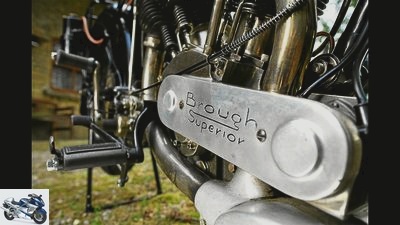
Gargolov
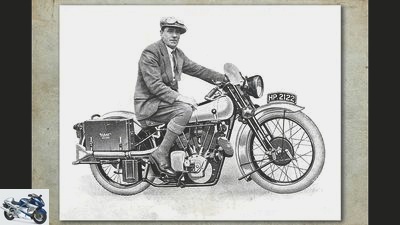
Gargolov
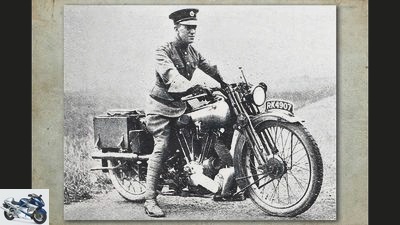
Gargolov
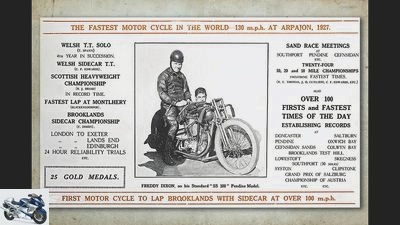
Gargolov

cutter
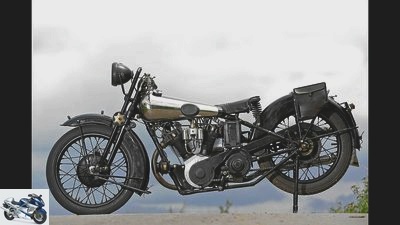
Gargolov
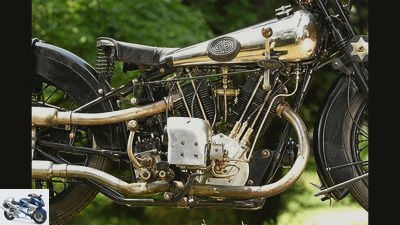
Gargolov
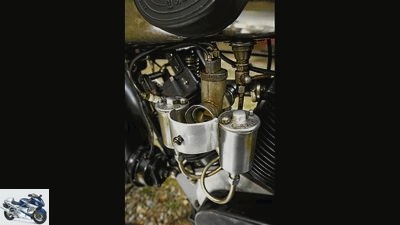
Gargolov
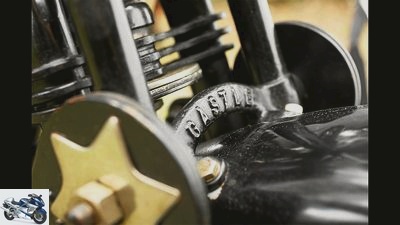
Gargolov
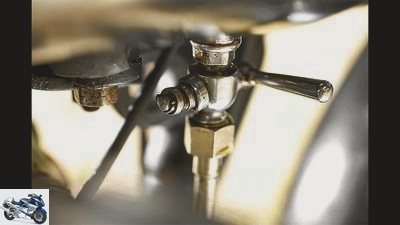
Gargolov

Gargolov
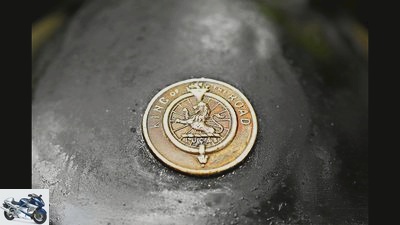
Gargolov
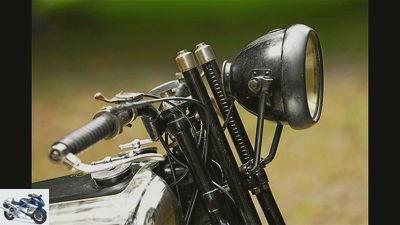
Gargolov
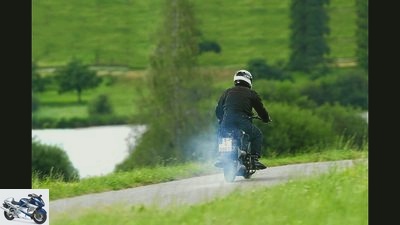
Gargolov
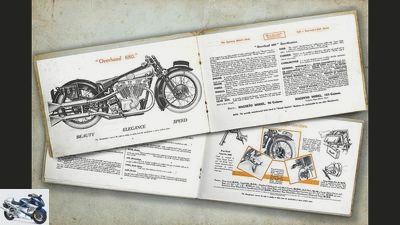
Gargolov
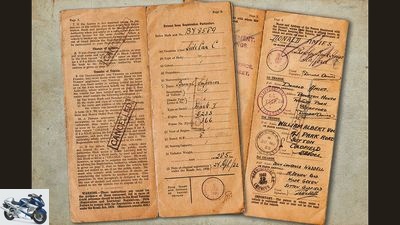
cutter
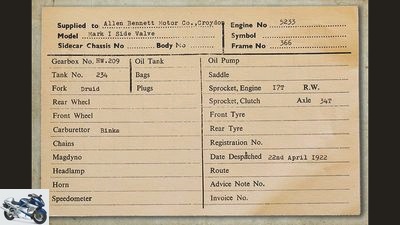
cutter
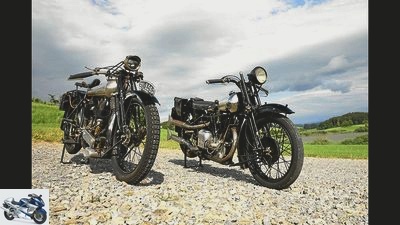
Gargolov
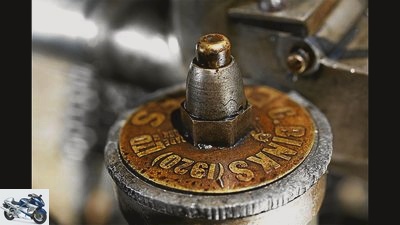
Gargolov
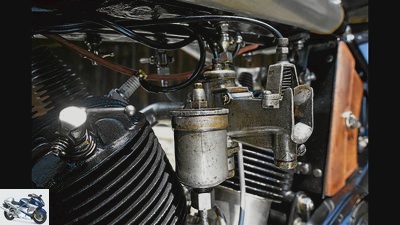
Gargolov
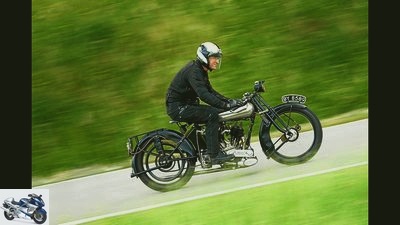
Gargolov
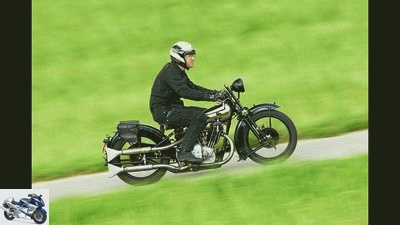
Gargolov
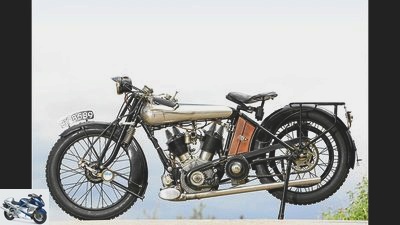
Gargolov
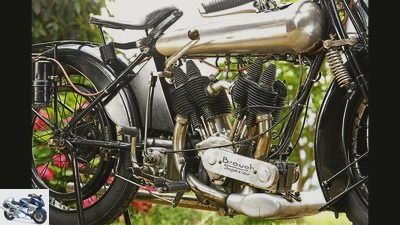
Gargolov

Gargolov
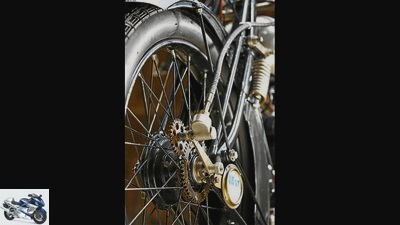
Gargolov
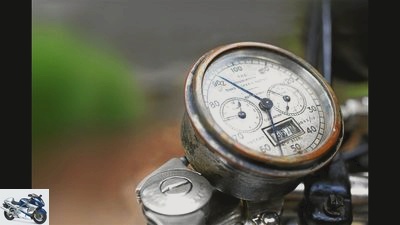
Gargolov
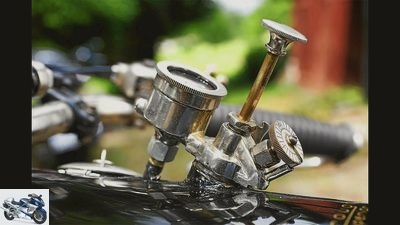
Gargolov
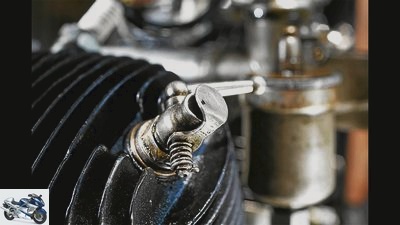
Gargolov
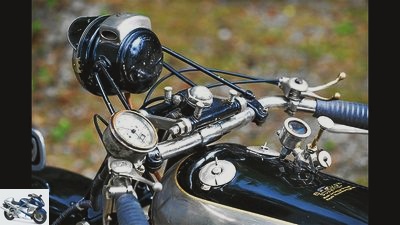
Gargolov
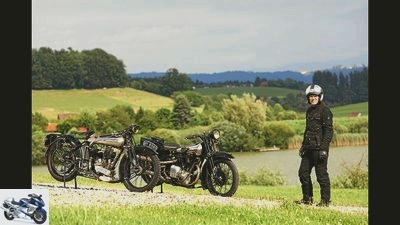
Gargolov
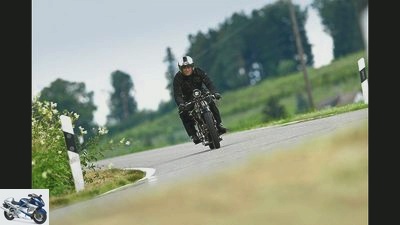
Gargolov
George Brough
Gargolov
From the brochure for 1927: George Brough on a racing SS 100 with touring equipment.
George Brough’s father, William, was a well-known motorcycle manufacturer. Since 1914/15 he has only been producing machines with horizontally installed boxer engines, because the smoothness of their running inspired him. After the First World War, George wanted his father to develop a high-quality V2 motorcycle. William Brough turned down this project for his company, but helped his son realize it on his own. It didn’t even prevent the name found at a bar flax shop for the new brand: Brough Superior – the better Brough. At the end of September 1920, the production of the new motorcycles was announced in “The Motor Cycle”, and “Mark 1” was presented in detail on December 23rd in the same magazine. With its high-quality workmanship, the saddle tank and the 980 JAP engine, which is unusually powerful for a solo motorcycle, it became a sensation. Within a short time, George Brough received 20 pre-orders including a deposit. A legend was born.
Colonel T.E Lawrence
Gargolov
Lawrence of Arabia bought seven Brough Superiors one after the other.
In 1923, “Lawrence of Arabia”, who became famous during World War I, withdrew from Middle East politics and from then on served as a simple soldier in the Royal Air Force under the name T. E. Shaw. Since then he has also been riding a motorcycle almost compulsively, often several hundred miles a day. In the story “The Road” (The Mint, Part 3, Chapter 16) he describes how his “excessive emotions” found their expression on the street. “As long as the streets were blue and straight, not lined with hedges, and empty and dry, as long as I was rich.” In letters to George Brough, Lawrence praised his motorcycles and bought seven Brough Superiors one after the other, all of which he named and numbered George. With George VII, an SS 100, he fell in May 1935 while avoiding two cyclists at high speed and died shortly afterwards of severe head injuries.
Racing successes
Gargolov
130 miles per hour correspond to 209.21 km / h.
When he started building motorcycles, George Brough was no longer a stranger. He had taken part in reliability rides on his father’s motorcycles since 1906 and won the London-Edinburgh-London Trial three times in a row from 1910. So he knew very well about the advertising value of such successes and used it skillfully to market his Brough Superior. In the high-tempo 1920s, speed records also developed a high advertising value and so Broughs took part in the general hunt for records. The 130 miles per hour advertised in the above brochure correspond to 209.21 km / h.
Related articles
-
Scene: Brough Superior 8-75 SS 100
Nakamura Scene: Brough Superior 8/75 SS 100 The big hammer Content of Can a 1000 cc motorcycle that only runs 100 mph be worth a whopping 200,000 euros?…
-
Presentation: novelty Brough Superior S.S. 100
Cathcart Presentation: Brough Superior S.S. 100 The Time Machine There is hardly any other machine that has as many myths as the Brough Superior SS …
-
Aston Martin and Brough Superior: AMB 001 with Turbo V2
Motorcycle fair in Milan EICMA 2019 Presented by Aston Martin 17th photos Aston Martin 1/17 Aston Martin and Brough Superior presented the first result…
-
With the versatile Velocette KSS Mark 1 Special on the move
Kel Edge On the move: Velocette KSS Mark 1 Special The versatile 1930s racing machine Contents of racing bike for the road or series motorcycle with …
-
On the move with the BMW R 69 S.
Gargolov 30th photos Gargolov 1/30 Gargolov 2/30 Gargolov 3/30 Gargolov 4/30 Gargolov 5/30 Gargolov 6/30 Gargolov 7/30 Gargolov 8/30 Gargolov 9/30…
-
Driving report Metisse 8V Mark 5
Nakamura Driving report Metisse 8V Mark 5 Twin shock Shocking! A Rickman Metisse all in green, with a tubular steel frame and two spring struts – but…
-
Projects from BMW and Moto Guzzi, Triumph Erlkonige
Lehmann Projects from BMW and Moto Guzzi, Triumph Erlkonige Winter blossoms The 2007 motorcycle vintage is already sprouting and blossoming. Still hidden…
-
BMW G 650 GS and Husqvarna TR 650 Strada in comparison
Gargolov 13 photos Gargolov 1/13 The Strada leads to a brisk pace on the route. Gargolov 2/13 Not perfect, but with a temperature display and average…
-
Artist Ducati 998 S Final Edition The Diva is leaving The 998 S Final Edition is without a doubt a motorcycle of today. But no matter where and how you move them ?? …
-
On the move with the Honda XL 600 V Transalp
Volker Rost 26th photos Peoples rust 1/26 Honda XL 600 V Transalp. Peoples rust 2/26 Until then, Honda had not had any luck with two-cylinder enduros….